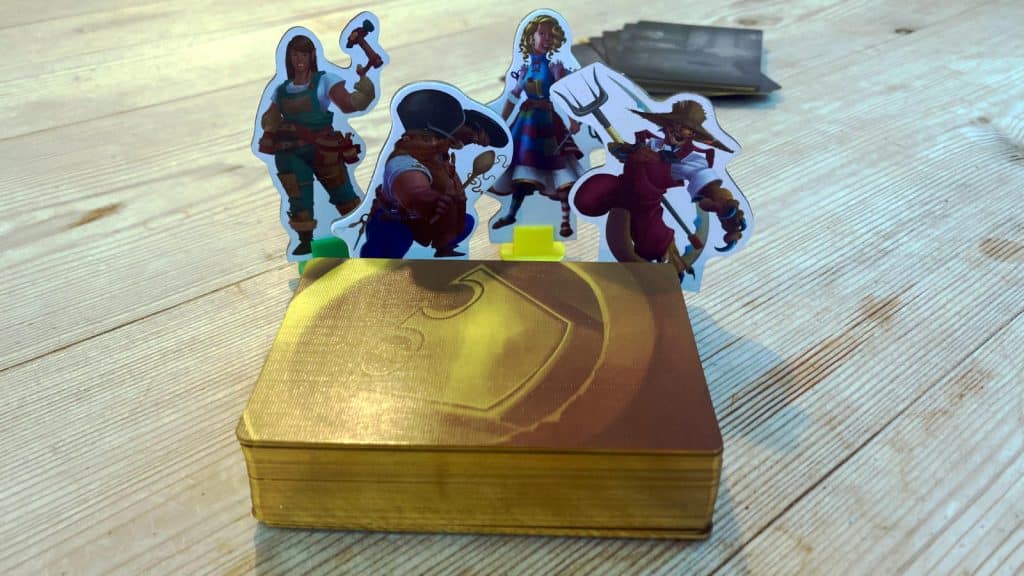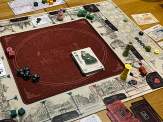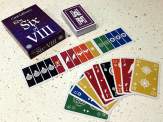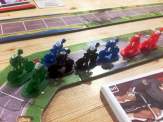| Release Date: 2024 | Players: 2-4 |
| Designer: Jeffrey D. Allers | Length: 30-45 minutes |
| Artist: Rick Bastos | Age: 8+ |
| Publisher: Gold Seal Games | Complexity: 1.0 / 5 |
| Plastic (by weight): <1% | Air (by volume): 25% |
The band of brave adventurers had finally arrived back in our town. They had returned jubilantly after clearing the local dungeons of the many monsters that had lurked in the deep caverns and tunnels. We celebrated with them because we no longer faced the threat of attacks. Not only that, now that the dungeons were clear of all dangers, we were able to scour them for treasure. The only problem was how to divide the riches we would find. It was clear, there was going to be a lot of Loot Dispute by Jeffrey D. Allers from Gold Seal Games.
Listen to the Audio Version
Intro Music: Bomber (Sting) by Riot (https://www.
Cinematic Experience by Alex-Productions | https://onsound.
Music promoted by https://www.
Creative Commons / Attribution 3.0 Unported License (CC BY 3.0)
https://creativecommons.
The introductory story sets the scene. You take on the role of one of the townsfolk who collate the treasures of each of the various dungeons and then have to find a way to split them amongst yourselves. That’s easier said than done though. It’s not simply a matter of collecting the most valuable loot. You have to choose the loot based on what the merchants back in the town are looking for. Only the player who comes back with the best combination of loot to fulfil the needs of the merchants is going to win.
I-Cut-You-Choose Loot
Loot Dispute is an I-cut-you-choose, also known as an I-split-you-choose, card game played over five rounds. At the beginning of each round, a certain number of loot cards is laid out in a specific pattern, dictated by the relevant dungeon card active for that round. The patterns are not neat grids, but jagged layouts that leave a few cards dangling off on different sides.
All you have to do on your turn is divide the loot along a straight line and stake your claim on one of the resulting groups of loot cards. So the first player divides the single group of loot into two, choosing one of them. The second player divides one of those two groups into another two, ending up with a total of three groups of loot cards, claiming one of the two resulting from their split. The third player divides one of the three loot groups into two as well, giving you four groups. If you divide a group of loot cards that was previously claimed by another player, you return their character back to them.
When the round comes back to you and your character is still on the loot group you claimed on your previous turn, you take all the loot cards and lay them out in front of you grouped by colour. You also take your character back and are now out of this round of loot splitting.
The round keeps going until everyone has successfully claimed a group of loot cards.
You do this a total of five times and then the game is over and you score up your points.

Scoring Conundrum
The way you score is based on the merchants you collect during the game. Every round when you claim your loot and take back your character, you also choose a merchant. The merchant defines what your cards are worth at the end of the game. Only your merchants affect your points. Other players’ merchants have no impact.
The scoring is a real point salad. You can score for sets of different colours, sets of different numbers of cards, for each pair of two differently coloured cards and a lot more. Some of the types of scoring work against one another. So you have to try and stay focused and not get distracted by the many scoring opportunities. You want to try and make sure your merchants synergize as much as possible.
Each round you can see the merchants available, so you can roughly plan what loot cards you might want. However, if you claim your loot after another player, they might take the merchant you had your eyes on. So timing can be important.
Getting the merchants you want can be tricky, but working out how best to carve up the loot is really the core of Loot Dispute. If you go for too big a haul, others are most likely going to carve it up further. Unless, of course, they desperately want a certain type of loot. A clever play can give you a big amount of loot, while making the other players feel like they get the more valuable prize for themselves. So you have to keep a keen eye on what everyone is doing.

Family Loot without Dispute
While the game does require a bit of focus and some planning, it’s very light. I think Loot Dispute works for a wide range of ages. Sometimes younger players are better at spotting the patterns of cards they need for their merchants, while older players are better at the table talk.
Ultimately, the fun is in how everyone carves up the stash of loot cards. It’s amazing how the groups get smaller and smaller. You want to convince other players to leave your haul alone. You might even want to barter and let someone else have the card they want, so you can get those that you need. Sometimes it’s actually better to cut off only one or two cards and let the other players fight over the rest, if those one or two cards are the ones you need for a good score or if it means that you are first to choose a merchant, allowing you to get the card you really want.
Timing your decisions right is really exciting. If you can gauge what other players around the table are after, you can often get away with claiming the cards you need.
Loot Dispute doesn’t take too long to explain and is relatively quick to play. It can sound a bit confusing at first, especially understanding how the merchants work. However, it’s best to just start playing, because after the first two rounds, everyone will know what they’re doing.
The rulebook is also really good and explains all the merchants in detail. There are also plenty of examples to make it easy to understand how it all works.
Loot Dispute is the sort of game that is going to become an evergreen in my collection. I know I can play it with all the family and even more “serious” gamers will enjoy the table talk and scheming that evolves as you play. It’s an allrounder and I am glad that I was able to claim this treasure.
If you enjoyed this article, please have a look at my support page to see how you can help keep the blog going.
Useful Links
- Loot Dispute: https://www.
goldsealgames. com/ product/ loot-dispute - Gold Seal Games: https://www.
goldsealgames. com/ - BGG listing: https://boardgamegeek.
com/ boardgame/ 362889/ loot-dispute
Videos
Transparency Facts
I feel that this review reflects my own, independent and honest opinion, but the facts below allow you to decide whether you think that I was influenced in any way. Please also read my Ethics Statement for more information.- I bought and paid for the game myself.
- At the time of writing, I have not received financial support from the publisher or anyone working on their behalf.
Audio Version
Intro Music: Bomber (Sting) by Riot (https://www.
Cinematic Experience by Alex-Productions | https://onsound.
Music promoted by https://www.
Creative Commons / Attribution 3.0 Unported License (CC BY 3.0)
https://creativecommons.
Playlist
These are the songs I listened to while I was writing this review:






